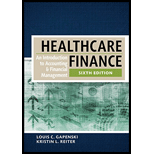
Healthcare Finance: An Introduction to Accounting and Financial Management
6th Edition
ISBN: 9781567937411
Author: Louis C. Gapenski, Kristin L. Reiter
Publisher: Health Administration Press
expand_more
expand_more
format_list_bulleted
Concept explainers
Expert Solution & Answer
Want to see the full answer?
Check out a sample textbook solution
Students have asked these similar questions
Need answer.
Solve plz now
Precious metal qn solve .
Chapter 5 Solutions
Healthcare Finance: An Introduction to Accounting and Financial Management
Ch. 5.1 - Prob. 1.1STQCh. 5.1 - Prob. 1.2STQCh. 5.1 - Prob. 1.3STQCh. 5.1 - Prob. 2.1STQCh. 5.1 - Prob. 2.2STQCh. 5.1 - Prob. 2.3STQCh. 5.1 - Prob. 2.4STQCh. 5 - Prob. 1.1STQCh. 5 - Prob. 1.2STQCh. 5 - Prob. 2.1STQ
Ch. 5 - Prob. 2.2STQCh. 5 - Prob. 2.3STQCh. 5 - Prob. 3.1STQCh. 5 - Prob. 3.2STQCh. 5 - Prob. 3.3STQCh. 5 - Prob. 4.1STQCh. 5 - Prob. 4.2STQCh. 5 - Prob. 4.3STQCh. 5 - Prob. 5.1STQCh. 5 - Prob. 5.2STQCh. 5 - Prob. 5.3STQCh. 5 - Prob. 5.4STQCh. 5 - Prob. 6.1STQCh. 5 - Prob. 6.2STQCh. 5 - Prob. 6.3STQCh. 5 - Prob. 6.4STQCh. 5 - Prob. 7.1STQCh. 5 - Prob. 7.2STQCh. 5 - Prob. 7.3STQCh. 5 - Prob. 7.4STQCh. 5 - Prob. 8.1STQCh. 5 - Prob. 8.2STQCh. 5 - Prob. 8.3STQCh. 5 - Prob. 8.4STQCh. 5 - Prob. 5.1QCh. 5 - Prob. 5.2QCh. 5 - Prob. 5.3QCh. 5 - Prob. 5.4QCh. 5 - Prob. 5.5QCh. 5 - Prob. 5.6QCh. 5 - Prob. 5.7QCh. 5 - Prob. 5.8QCh. 5 - Prob. 5.9QCh. 5 - Prob. 5.1PCh. 5 - Prob. 5.2PCh. 5 - Prob. 5.3PCh. 5 - Prob. 5.4PCh. 5 - Prob. 5.5PCh. 5 - Prob. 5.6PCh. 5 - Prob. 5.7PCh. 5 - Prob. 5.8PCh. 5 - Prob. 5.9P
Knowledge Booster
Learn more about
Need a deep-dive on the concept behind this application? Look no further. Learn more about this topic, finance and related others by exploring similar questions and additional content below.Similar questions
arrow_back_ios
SEE MORE QUESTIONS
arrow_forward_ios
Recommended textbooks for you
 Cornerstones of Cost Management (Cornerstones Ser...AccountingISBN:9781305970663Author:Don R. Hansen, Maryanne M. MowenPublisher:Cengage Learning
Cornerstones of Cost Management (Cornerstones Ser...AccountingISBN:9781305970663Author:Don R. Hansen, Maryanne M. MowenPublisher:Cengage Learning Essentials Of Business AnalyticsStatisticsISBN:9781285187273Author:Camm, Jeff.Publisher:Cengage Learning,
Essentials Of Business AnalyticsStatisticsISBN:9781285187273Author:Camm, Jeff.Publisher:Cengage Learning, Essentials of Business Analytics (MindTap Course ...StatisticsISBN:9781305627734Author:Jeffrey D. Camm, James J. Cochran, Michael J. Fry, Jeffrey W. Ohlmann, David R. AndersonPublisher:Cengage Learning
Essentials of Business Analytics (MindTap Course ...StatisticsISBN:9781305627734Author:Jeffrey D. Camm, James J. Cochran, Michael J. Fry, Jeffrey W. Ohlmann, David R. AndersonPublisher:Cengage Learning Managerial AccountingAccountingISBN:9781337912020Author:Carl Warren, Ph.d. Cma William B. TaylerPublisher:South-Western College Pub
Managerial AccountingAccountingISBN:9781337912020Author:Carl Warren, Ph.d. Cma William B. TaylerPublisher:South-Western College Pub Financial And Managerial AccountingAccountingISBN:9781337902663Author:WARREN, Carl S.Publisher:Cengage Learning,
Financial And Managerial AccountingAccountingISBN:9781337902663Author:WARREN, Carl S.Publisher:Cengage Learning,

Cornerstones of Cost Management (Cornerstones Ser...
Accounting
ISBN:9781305970663
Author:Don R. Hansen, Maryanne M. Mowen
Publisher:Cengage Learning

Essentials Of Business Analytics
Statistics
ISBN:9781285187273
Author:Camm, Jeff.
Publisher:Cengage Learning,

Essentials of Business Analytics (MindTap Course ...
Statistics
ISBN:9781305627734
Author:Jeffrey D. Camm, James J. Cochran, Michael J. Fry, Jeffrey W. Ohlmann, David R. Anderson
Publisher:Cengage Learning

Managerial Accounting
Accounting
ISBN:9781337912020
Author:Carl Warren, Ph.d. Cma William B. Tayler
Publisher:South-Western College Pub

Financial And Managerial Accounting
Accounting
ISBN:9781337902663
Author:WARREN, Carl S.
Publisher:Cengage Learning,